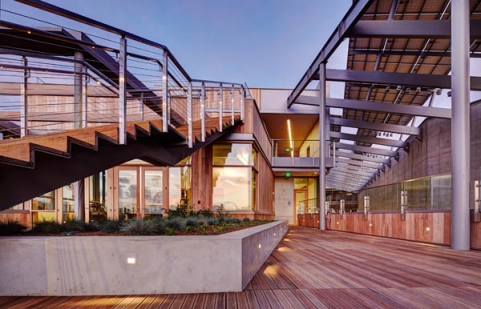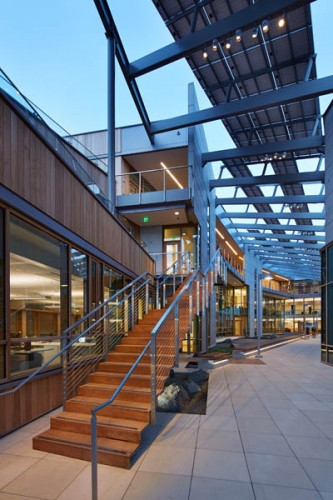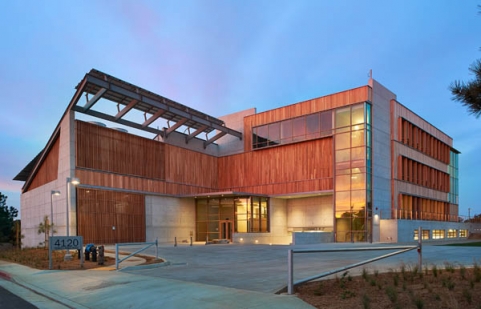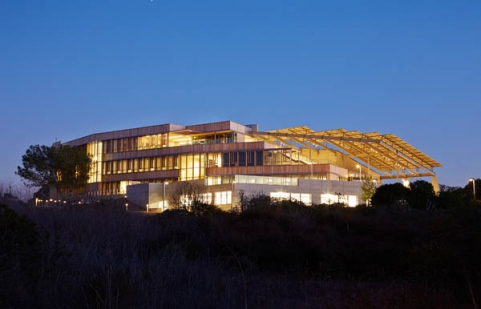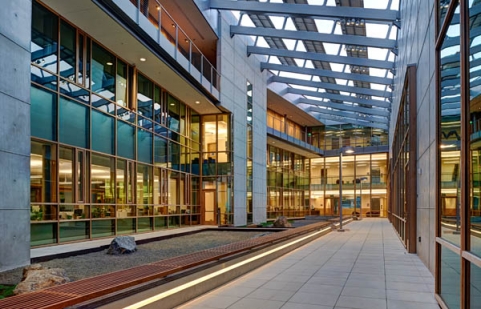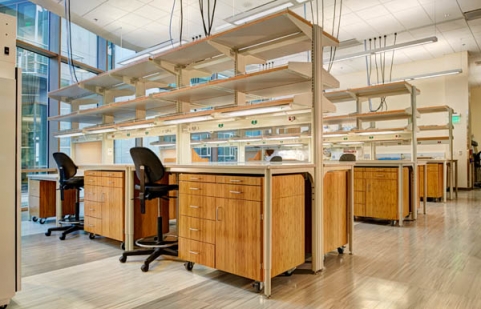Bringing to life what is sure to become one of San Diego’s most iconic buildings, McCarthy Building Companies, has completed construction for the new J. Craig Venter Institute (JCVI) in La Jolla, Calif., located on a 1.75-acre site on the University of California, San Diego campus.
Designed by Zimmer Gunsul Frasca Architects (ZGF), the three-story, 45,000-sf building is an apt tribute to its prominent, coastal location, with its long, slender shape.
Exposed architectural concrete panels, Spanish cedar wood siding, a wood-framed window curtain wall and storefront system, metal panels, and an expansive photovoltaic array give this building its signature identity.
The net-zero-energy facility represents the most ambitious sustainably designed biological research laboratory project ever to be built and is integral to JCVI’s quest to perform the science needed to solve critical environmental and human health challenges. The landmark building has been built to earn LEED Platinum Certification.
“Our new facility was built not only to advance genomic research, but to showcase how science can be compatible with the best of environmentally sustainable practices,” said JCVI Founder and CEO J. Craig Venter, PhD.
The new JCVI currently has about 90 employees but is designed to house approximately 125 scientists and staff. The JCVI teams are focused on a variety of genomic research areas, including continued work in synthetic biology; sampling and analysis of the world’s oceans, fresh water and soils to better understand the microbes living in these environments; and new analysis on the human genome in the hopes of discovering new insights into disease prevention and treatment.
The location of the facility, on land leased from UCSD, was chosen for its proximity to and potential for collaboration with the many renowned academic research centers in the La Jolla area.
The facility comprises a three-story, 28,600-sf office wing and a single-story, 12,605-sf laboratory wing. The laboratory and office wings are perched atop the roof/podium deck of the partially below-grade parking garage.
Solid-core cedar wood frames the windows—some 40 feet high—and bamboo flooring adorns the lobbies and interactive areas.
Large conference rooms are equipped with high-tech systems to facilitate video conferencing and collaboration with numerous global collaborators.
The west end of the third floor provides myriad social spaces, complete with a cafeteria and small kitchen for staff, and a private conference room dedicated to Dr. J. Robert and Betty J. Beyster, who in April 2013 donated $2.5 million to JCVI.
The light-filled laboratories have 14-foot-high ceilings, with floor-to-ceiling windows on two sides. A catwalk above the labs enables easy servicing of mechanical systems without disturbing the scientists working below. Energy and water usage is carefully monitored.
The concrete walls, columns, footings, slab on grade, slabs on metal deck, and podium deck utilize 30% fly ash, which contributes to the LEED credits in the category of Recycled Content.
For optimum aesthetic appeal, the exposed architectural walls and columns use Type III cement and feature outward ribs separating each panel. Concrete cast-in-place stairways further add to the clean, modern look of the building.
McCarthy self-performed all the concrete work, drawing on the expertise of the same concrete specialist who oversaw work on the Salk Institute for Biological Studies East Building Addition, which McCarthy completed in 1995.
To meet the client’s goal of creating the most sustainable laboratory in the world, the facility incorporates high performance architecture, low-energy-use systems, water conservation strategies, and onsite renewable power generation. The building massing and envelope are designed to maximize the use of daylight while reducing overall building energy use.
Being net-zero for electrical energy, the building will produce as much electricity on-site as it consumes annually. This is made possible by integrating numerous energy efficiency measures throughout the building systems and using advanced building technologies such as a Lutron lighting control system that senses when and how much light is needed by occupants at any given time of day. The building also incorporates operable windows.
On-site renewable energy is generated through the sizeable photovoltaic roof. The project team also pursued aggressive water conservation. Rainwater and condensation will be collected and stored in giant underground cisterns with a total capacity of 90,000 gallons. The water will then be filtered and used for operation of cooling towers, toilet flushing and site irrigation. About two-thirds of the building’s water use will be supplied by rainwater.
Other sustainable design strategies include recycled content, natural ventilation and passive cooling, low-water landscaping, high-efficiency plumbing, sustainably harvested wood, and use of regional materials.
“Target value design played the most critical role in the overall planning and coordination of this project,” said McCarthy Project Director Craig Swenson. “McCarthy was brought in early to perform preconstruction with the goal of significantly lowering the initial estimated construction costs while still allowing the client to achieve LEED Platinum status. This target value design approach enabled us to maintain the integrity of the highly sustainable design while also making the budget work for the client.”
Swenson said that target value design also allowed the project team to give adequate time and thought to such items as wood procurement, which was done a year in advance.
Advanced technology additionally played a key role. The project team utilized Building Information Modeling, Navis Works, and Bluebeam for the electronic plan room, which McCarthy personnel were tasked to manage as one of many ways of keeping project costs in check.
About J. Craig Venter Institute
The J. Craig Venter Institute (JCVI) is a not-for-profit research institute dedicated to the advancement of the science of genomics; the understanding of its implications for society; and communication of those results to the scientific community, the public, and policymakers. Founded by J. Craig Venter, Ph.D., the JCVI is home to approximately 250 scientists and staff with expertise in human and evolutionary biology, genetics, bioinformatics/informatics, information technology, high-throughput DNA sequencing, genomic and environmental policy research, and public education in science and science policy.
About McCarthy Building Companies, Inc.
For 150 years, McCarthy has been building communities across America, both by constructing essential projects communities rely on, as well as by helping those who need assistance. The company is committed to the construction of high performance green buildings; progressive job site technology; and safer, faster and more cost-effective execution. In addition to San Diego, McCarthy has offices in Newport Beach, Sacramento and San Francisco, Calif.; Phoenix; Las Vegas; St. Louis; Dallas; Houston; Atlanta; Albuquerque; Kansas City; and Collinsville, Ill. McCarthy is 100 percent employee owned. More information about the company’s history is available online at www.mccarthy150.com or by following the company on Facebook, Twitter, LinkedIn and Google+.
Related Stories
Retail Centers | May 3, 2024
Outside Las Vegas, two unused office buildings will be turned into an open-air retail development
In Henderson, Nev., a city roughly 15 miles southeast of Las Vegas, 100,000 sf of unused office space will be turned into an open-air retail development called The Cliff. The $30 million adaptive reuse development will convert the site’s two office buildings into a destination for retail stores, chef-driven restaurants, and community entertainment.
Codes and Standards | May 3, 2024
New York City considering bill to prevent building collapses
The New York City Council is considering a proposed law with the goal of preventing building collapses. The Billingsley Structural Integrity Act is a response to the collapse of 1915 Billingsley Terrace in the Bronx last December.
Architects | May 2, 2024
Emerging considerations in inclusive design
Design elements that consider a diverse population of users make lives better. When it comes to wayfinding, some factors will remain consistent—including accessibility and legibility.
K-12 Schools | Apr 30, 2024
Fully electric Oregon elementary school aims for resilience with microgrid design
The River Grove Elementary School in Oregon was designed for net-zero carbon and resiliency to seismic events, storms, and wildfire. The roughly 82,000-sf school in a Portland suburb will feature a microgrid—a small-scale power grid that operates independently from the area’s electric grid.
AEC Tech | Apr 30, 2024
Lack of organizational readiness is biggest hurdle to artificial intelligence adoption
Managers of companies in the industrial sector, including construction, have bought the hype of artificial intelligence (AI) as a transformative technology, but their organizations are not ready to realize its promise, according to research from IFS, a global cloud enterprise software company. An IFS survey of 1,700 senior decision-makers found that 84% of executives anticipate massive organizational benefits from AI.
Codes and Standards | Apr 30, 2024
Updated document details methods of testing fenestration for exterior walls
The Fenestration and Glazing Industry Alliance (FGIA) updated a document serving a recommended practice for determining test methodology for laboratory and field testing of exterior wall systems. The document pertains to products covered by an AAMA standard such as curtain walls, storefronts, window walls, and sloped glazing. AAMA 501-24, Methods of Test for Exterior Walls was last updated in 2015.
MFPRO+ News | Apr 29, 2024
World’s largest 3D printer could create entire neighborhoods
The University of Maine recently unveiled the world’s largest 3D printer said to be able to create entire neighborhoods. The machine is four times larger than a preceding model that was first tested in 2019. The older model was used to create a 600 sf single-family home made of recyclable wood fiber and bio-resin materials.
K-12 Schools | Apr 29, 2024
Tomorrow's classrooms: Designing schools for the digital age
In a world where technology’s rapid pace has reshaped how we live, work, and communicate, it should be no surprise that it’s also changing the PreK-12 education landscape.
Adaptive Reuse | Apr 29, 2024
6 characteristics of a successful adaptive reuse conversion
In the continuous battle against housing shortages and the surplus of vacant buildings, developers are turning their attention to the viability of adaptive reuse for their properties.
AEC Innovators | Apr 26, 2024
National Institute of Building Sciences announces Building Innovation 2024 schedule
The National Institute of Building Sciences is hosting its annual Building Innovation conference, May 22-24 at the Capital Hilton in Washington, D.C. BI2024 brings together everyone who impacts the built environment: government agencies, contractors, the private sector, architects, scientists, and more.


